This is me! Peter Aringer.
Why do i build a plane???
Hi there! I’m a car mechanic master craftsman , pilot and aircraft builder and this is my build log website. I live in Herford, Northern Germany, have 4 great adult children and 2 grand children. And I like creating and building things by my own. I´m building the RV-10 in a seperate workshop in my company. This gives me the opportunity to build in a pleasant environment over the entire year.

Master Craftsman Peter Aringer at work….
On this page I will try to explain why (in the world) I have decided to build my own airplane vs buying one. Can you truly explain a dream???
How to make a dream come true
I started flight training in Bielefeld EDLI in October of 2010. I’m sure anyone who’s been through flight training can tell, that once you start flying, you start dreaming about owning a plane someday. My instructor had a very good advice, which I followed: „After completing your license first fly about one year in our flight club to clarify what is your flight mission“.
My mission was to take up to 4 people (or two people, and much luggage) on a long cross country trip, flying fast and as cheaply as possible.
After one year flying Cessna, Piper and Cirrus planes in my flight club LSV Gütersloh-Bielefeld e.V. I went one evening to a hangar and saw this nice plane like looking microlight BRISTELL from BRM Aero, Czech Republic. Talking to the seller Axel Rönneker, I purchased it after only 6 weeks. This thing is an amazing plane with lots of leg- and headroom and the most wide cabin in the microlight category you can buy for money.
From model planes to the real ones
Beeing a model plane builder since the age of 12 I now started off looking at something building by my own. Or buying an almost flying certified plane out of the general aviation category. Cessna 172’s, which are basically the Ford Taunus of the skies was my first choice. And even though they have 4 seats, they don’t have the lifting capacity (useful load) to take 4 adults and still be able to take fuel. They are also slow, cruising at about 110 knots while burning 40 Liters AVGAS per hour. The 172’s big brother is the 182. It’s a larger version of the 172 which can actually take 4 adults and enough fuel to fly for a few hours. It’s also faster, cruising at 140-145 knots, but it’s burning also much more fuel (55 Liters AVGAS per hour).
I also looked at the Mooneys, which are fast, fuel efficient airplanes. Depending on the model, these planes will cruise between 150-160 knots. They only burn 45 Liters per hour. Looks great, but there are a few downsides: First, they have retractable landing gear, which is more expensive to maintain, and not ideal for landing on soft runways. And second, they are overall much more expensive to maintain.
While looking for a new big project, I noticed that there are people out there building their own airplanes. So – why shouldn´t I do this too? There are a few kit planes to carry four people. There is a composite plane called LANCAIR Maco, and an aluminum plane called RV-10 from Van´s Aircraft.
These are both beautiful planes that fit 4 real people, are both fast cruising, and fuel efficient. The LANCAIR Maco will cruise over 200 knots, and the RV10 will cruise about 160-170 knots, both burning close to 40 Liters per hour. This is a better fuel economy than my Dodge Charger SRT-8!
The final choice
As a result I ended up choosing the RV-10 over the LANCAIR Maco for a number of reasons:
- The Price: The LANCAIR Maco will cost about half a million Euros. The RV-10 will cost about 180.000 Euros – which is what I can afford by saving some money over the long cours of years of building it.
- Composite vs Aluminum. I’m just personally more comfortable working with metal than fiberglass. Other than building the model planes over the last 20 years. But this is annother big „house number“ (this is German English). So handling metal I´m much more confident with….
- Short field performance. The RV-10 has a very goog shortfield take off performance!
- Window size. I´m always afraid of air-to-air collisions. Because of this I want as much window area as I can get, to have the most possible situational awareness.
- The Community. You can’t beat the support of THOUSANDS of builders in forums like VansAirforce.com and the Matronics email lists. There are also many build logs that go step by step through the build process, like Tim Olson’s site MyRV10.com or Ed Kranz´s site GoodPlaneLiving (my personal favorite).
Going to begin a long journey
So after a lot of research, a lot ot soul searching, and lot of me talking to myself better not to start such a big and endless project, at least I ended up deciding to build this RV-10! In the end, I will have an aircraft that can fly 175 knots, carry 4 adults with full fuel and a little baggage, get better fuel economy than with my Charger SRT-8, and have more capability in the panel than most certified planes – near to some airliner-cockpits. As an added bonus, the LBA (LuftfahrtBundesAmt) sees the builder of a homebuilt as the „manufacturer“. Therefor I can do all the maintenance on my plane by myself. This not only saves money, but allows me to fully know every part of the plane. This is also the reason I decided to go with a slow build kit, and not to go with a quick build kit. (would safe about 40% building time). When this thing will be finished I proudly can tell: „I did that all with my own hands by myself“.
